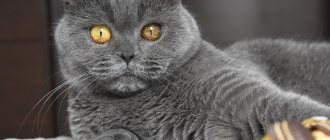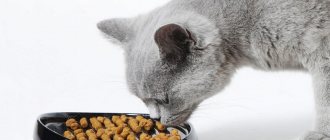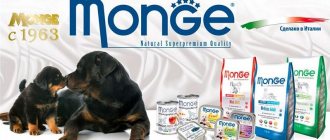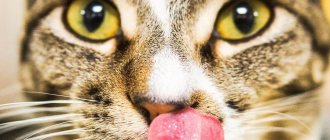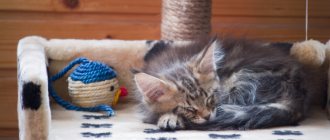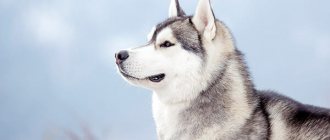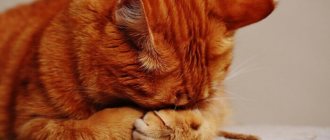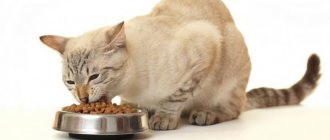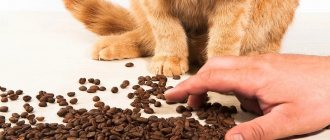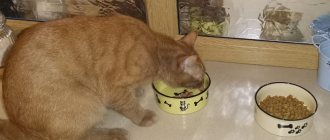British newborns, what they look like, photos
Outdoor cats choose dark, warm places to give birth, usually basements and attics. At home, you need to provide a “birther” for the British woman. It can be made from a large box, 60x60 cm in size, 40 - 50 cm high. Store banana boxes and exhibition tents are suitable. Lay out a diaper for animals and a heating pad.
Depending on the number of kittens in the cat’s womb, a newborn kitten can have a body length of 8 - 12 cm, the weight of kittens is from 70 - 120 g, there are small ones of 50 - 60 g, this happens when there is a multiple pregnancy. Weight table here.
The British are born blind, deaf, with large claws, without undercoat, the fur is not able to warm the baby, so you need to monitor the temperature of the “birthing place” ≈ 38 - 39 C⁰. At the age when kittens sleep 95% of the time, their innate sense of smell and touch allows them to find the cat's nursing nipple. The British mother licks the kittens; without her, they are unable to defecate. In the period from birth to 2 - 3 weeks, you should monitor the daily weight gain of babies by 10 - 20 grams, they should be weighed in the morning at the same time. If someone does not finish eating, then put it on the nipple more often.
Photo – British kittens 3 days old
Stages of development of a newborn British baby by day:
- Days 1 – 3 – baby sleeps, eats; how to determine the sex of newborn kittens is described in detail here
- 3 – 6 days – the umbilical cord heals, becomes black, dries out, and falls off;
6 days per photo
the picture shows that some already have an umbilical cord missing
- 4 – 7 days – hearing is formed, there is a reaction to loud sounds. The British are all straight-eared!
Plush kittens at 1 week
During this period, babies begin to crawl more actively, and many begin to open their eyes. Children's undercoat is formed and they react more actively to sounds.
British 7 days | 1 Week
It's time to increase the area for cats and choose a name.
British kittens in a playpen
Video of the British in 10 days below.
Little kitties 2 weeks old
British Shorthairs grow quickly, their weight has tripled since birth. They began to sleep less, eat less often, but the portions became larger. They begin to walk unsteadily, with long claws allowing them to maintain balance. By the end of the second week, the eyes open, they will immediately be a little cloudy. The first eye color is blue. They are seen a couple of days after opening on days 14–17. They hear the cat better and respond to its purring.
2 weeks
14 days
British 3 weeks
Kitties see and hear everything, sit and walk confidently, and try to jump. Baby teeth are visible. They are very curious and try to get out of their beds, so it is worth using fences and playpens. The area for children to play should be increased. Provide a scratching post, soft toys, a tray with filler and water.
The cubs actively play with each other, bite and hiss, and practice hunting skills.
2.5 weeks
3 weeks
What to feed the baby if the cat does not feed him?
Kittens can be given cow's or goat's milk, but only if absolutely necessary or in an emergency. What should you feed your baby on a regular basis if maternal feeding is not possible? There are very strict requirements for the kitten's menu. Food should be nutritious and high in calories so that the baby grows quickly and gains weight. Food should be given only in soft form - solid foods are contraindicated for baby cat food.
Review of finished products
Ready-made formulas for feeding kittens in the form of dry powder are sold in pet stores. In the absence of natural feeding, this is the best option for healthy and nutritious nutrition of the animal. Mixtures from different manufacturers may differ in composition. It is necessary that the product contains the necessary minerals, macro- and microelements - calcium, zinc, iron, iodine, valuable omega-3 and omega-6 fatty acids, vitamins B, C and E.
When choosing a mixture, you should take into account the age, size and breed of the kitten. Large Maine Coons and Kurilian Bobtails require more calories per serving than miniature babies.
Which manufacturer should you prefer? Everything is individual; the same product may be ideal for one pet and completely unsuitable for another. For a newborn kitten, you can purchase the Beaphar Kitty-Milk mixture produced in the Netherlands. The product is safe for the baby's health and contains the optimal amount of calories, nutrients, vitamins and minerals. For weakened and underweight babies, German Cat-Milk powdered milk with a high taurine content is more suitable.
If we consider the budget segment, the American “Milk for Kittens” mixture has a good composition. It contains calcium for strong bones, taurine for heart and eye development, lysine for respiratory health, and linoleic acid to support kitty's healthy skin and coat.
The cat's milk replacer from Royal Canin will appeal to your baby, as the smell is very reminiscent of mother's milk. This mixture, in addition to proteins and vitamins, contains fish oil, natural oils and fructo-oligosaccharides, which promote the proper physical development of the pet and strengthen its immunity.
Homemade Blend Recipes
It is not necessary to purchase ready-made mixtures in the store; healthy and tasty food for your kitten can be prepared at home. In the absence of allergies or intolerance to pasteurized cow's milk, the mixture can be made based on it. To do this you will need the following ingredients:
- 1 glass of milk, heated to 40–45°C;
- 2 yolks;
- 1 tsp. sunflower or other vegetable oil;
- multivitamin complex in drops.
You can use human breast milk substitutes, such as Nutrilon. Instructions for preparing 1 serving are indicated on the package. This option is not suitable for regular feeding of a kitten, but it can help out once in an emergency situation in the absence of cat milk formula.
For newborn kittens, you can prepare the mixture according to the following recipe:
- take condensed milk (20%) without added sugar;
- add bone meal at the rate of 1 tbsp. l. per 1 liter of liquid;
- mix the ingredients.
The baby should be fed using a syringe, pipette or a special bottle with a nipple for small animals, very carefully. Before feeding, the mixture must be warmed to 40°C. It is not recommended to store the finished product; this should be taken into account when preparing a portion. You cannot overfeed a kitten with ready-made or homemade formula - this can lead to intestinal upset and stool problems.
Kitten 1 month
The period of appearance of bear-type kittens. Month-old kittens are formed unevenly; a large body on short thick legs reminds us of a small bear. They sleep 16–20 hours, are very active, and play a lot.
4 weeks
Month-old kittens drink water on their own for 4 weeks, many eat wet and dry food themselves, and go to the litter box. Time to work with the kitten and adapt to the hands, teaching manners. The “change of color” of the eyes from blue to orange (for blue color), this happens gradually.
1 month
5 – 6 weeks | After 1.5 months, the kitten licks its fur and washes itself, the undercoat thickens, and the color becomes brighter.
5 weeks
At 7–8 weeks, babies are still drinking their mother’s milk and learning cat wisdom from her. The eyes acquired their color, became bright and clear.
1.5 months
Menu for a healthy adult animal for 3 days with recipes
It is not easy to think through a balanced diet for a British cat, taking into account all the recommendations. An approximate menu for an adult animal for 3 days with recipes for dishes that can easily be prepared at home is as follows (serving size indicated for a pet weighing 4 kg):
| Morning (80 g) | Evening (150 g) | Meat recipe | |
| 1 day | Cottage cheese 5% fat (30 g), fermented baked milk (50 g), egg yolk | Beef with broccoli or cauliflower | Cut 100 g of raw defrosted meat into small cubes, mix with 50 g of chopped boiled cabbage (you can take baby puree in a jar), add 0.5 tsp. olive oil, stir. |
| Day 2 | Kefir with bran | Salmon with rice | Boil 100 g of fish fillet and 15 g of rice, season with finely chopped parsley and sunflower oil. |
| Day 3 | Natural yogurt | Chicken liver with pumpkin and oatmeal | Boil 100 g of offal and 20 g of pumpkin, pour boiling water over 10 g of oatmeal and leave to swell, mix everything, season with vegetable oil. |
Source
British kitten 2 – 3 months
Kittens feed themselves, go to the toilet, and play. They are very curious and it is worth taking care of their safety: close the windows, remove poisonous plants, dangerous sharp toys, threads, buttons. They suck a cat out of habit; they will do this until they are weaned or the cat stops letting them come to them. The paws of kittens lengthen and no longer resemble bear cubs, all this is due to uneven development. Character begins to emerge. It is worth spending more time raising children, teaching them to use a comb and a scratching post. Two months – it’s worth carrying out the first deworming and getting vaccinated; more about vaccinations here. Three months – repeated vaccination against viral infections and rabies vaccination are carried out. After three months, the kitten is considered socially adapted and can move to a new home.
Primary requirements
Every cat owner should remember that your pet is one hundred percent a predator. This is where cats differ from dogs - over thousands of years of domestication, dogs have learned to eat the same food that their owner eats, but cats still require meat in order to grow and develop normally.
British babies are no exception in this regard. The basis of their diet should be meat . It is recommended to feed a British cat beef products. This meat is easily digested by your furry pet's delicate stomach.
It is best to feed cooked meat, as raw ground beef may contain parasitic larvae that are dangerous not only to cattle, but also to predators.
© shutterstock
Kitten 4 months – 1 year
Age 4 months – the number of meals is reduced, growth slows down, activity is high. Baby teeth begin to fall out.
5 months – the skeleton of the animal is formed, the pattern on solid colors practically disappears.
6 months – we see not a kitten, but an almost fully formed Briton. The coat needs weekly brushing. If the animal will not participate in breeding, then it is worth castrating or sterilizing it. 7 months – the male cat reaches sexual maturity. After 8 months, the British are considered adults. You should monitor your pet's diet.
12 months – gradually transfer the cat to adult or sterilized food. Read more about cat nutrition here.
adult blue shorthair at 14 months
From the age of 10 months, the British can participate in exhibitions, open class. You should visit a veterinarian annually and adjust your vaccination schedule. The British breed is fully formed by 2 - 3 years. Reviews from owners indicate that after castration, kittens do not become less active than before. The main thing is the desire to care and play with your pet.
General recommendations
The cat’s diet must be selected based on its health status and age characteristics. Food intended for feeding adults and absolutely healthy pets is absolutely not suitable for kittens or animals with any pathologies.
Healthy eating rules
The domestic cat has not lost its natural predatory instincts, which is reflected in the food it consumes.
Under natural conditions, meat proteins enter the cat’s body in raw form, and plant carbohydrate foods enter in a semi-digested form, therefore the nutritional characteristics of a pet require strict adherence to the following rules:
- the diet must necessarily include components of animal and plant origin, represented by meat, cereals and vegetables;
- Poultry and beef will benefit the cat’s body, but the use of pork in the diet should be avoided;
- cereal crops that are harmless to the body of a domestic cat are represented by oatmeal, buckwheat, barley and rice cereals;
- Healthy vegetable crops include non-starchy root vegetables in the form of beets and carrots, as well as white cabbage or cauliflower, cucumbers and zucchini;
- dairy foods should be represented by low-fat and unsweetened fermented milk products, including kefir, fermented baked milk and cottage cheese.
Pre-treatment of food products is not always carried out. Meat and vegetable products are given raw or boiled, and cereals are used for cooking porridge.
Natural nutrition
This option for feeding the “British” can be used by owners who have free time to prepare natural food for their pet. The range of possible food products used in a cat’s diet includes meat, low-fat sea fish, fermented milk products, as well as various cereals and vegetables.
Meat in the form of beef, rabbit or poultry must be fresh. Such meat may contain larvae of parasites or pathogens of various infections, so heat treatment, represented by pre-freezing, is considered the best option. After defrosting, the meat is doused with boiling water. This method allows you to obtain food that is as close as possible in structural characteristics to canned food, but retains all its beneficial properties.
A good alternative to meat would be to include low-fat oceanic fish in the diet of a British cat, such as hake, cod, pollock and saffron cod. The fish must be lightly boiled and thoroughly removed from the bones. Fermented milk products can be seasoned with special bran for pets, which is rich in B vitamins, serves as a source of essential fiber, and has a beneficial effect on the condition of the cat’s coat.
Dry and wet food
Dry food is the cheapest option and is virtually hassle-free for British cat owners. However, many experienced cat owners and specialists do not consider this food to be sufficiently suited to the characteristics of the digestive system of a pet. It is best to use dry food that does not contain carbohydrates of plant origin, and also alternate it with wet meat-and-vegetable food.
Pedigree feed lines
Recently, the so-called pedigree food lines have been especially popular among owners of “British” dogs. For example, BRITISH SHORTHAIR food is produced, which has a balanced composition that is optimally suitable for a British cat.
The Super Premium series uses the highest quality ingredients. The composition can be represented by turkey, lamb or chicken meat, eggs, and high-quality cereals. Such feeds are well digestible, have a higher calorie content, and the components are characterized by high nutritional value.
Birth
In general, cat pregnancy lasts about 56-63 days. The period depends on the breed for many other reasons. It is impossible to say exactly how long cats are pregnant or how long gestation lasts. Factors influencing duration:
- Weight.
- Presence of previous attacks.
- The relationship between the time of the first estrus and mating.
It is advised to breed a female cat on her third heat, trying to avoid protracted previous periods. If the pet is taken to a partner earlier, the animal will bear kittens for about 50 days. The babies may appear premature or dead.
The weight of the pet is also important when determining the timing of the cat's death. Small beauties, weighing about 3 kg, bear kittens faster, how long do small British cats walk before permission is known. Cubs appear earlier, at 55-56 days. Large adult, sedentary individuals migrate at 64-65 days and can walk beyond the established period.
How many kittens an animal gives birth to depends on the time at which the process occurs; a British cat brings no more than three babies for the first time. Typically, primiparous cats are delivered on time at 63 days. Labor lasts approximately 2 to 14 hours.
It often happens that there is only one kitten in the first litter. And this is from mating with a pet, which can produce up to 7-8 babies. There is no need to be afraid and try to stimulate the appearance of more: each animal’s body has its own characteristics. It is not so important the number of litters a cat produces from the first time, and how many kittens the British favorite will give birth to. You need to worry about the condition of the animal and its offspring.
When to start - tips
Small pets should not be taken away from their mother too early. The main reason for this rule: the baby must be fed breast milk and will learn hygiene skills from an adult cat. The optimal age for moving to another family is 3 months, the cub will be about 12 weeks old.
Smell and touch are the main helpers of a kitten in the first days of birth. The baby does not hear or see yet: he finds his mother’s warm side and nipple by smell. The organs of vision begin to function 10-14 days after lambing. In many ways, the opening of the eyes depends on gestation, that is, on how long the cat carried the kitten. Premature babies will develop the ability to see later. Those born later will see the world faster.
The development of female pets is more intensive. The girl's eye slits become wider earlier than those of her furry brothers. The breed of the animal also matters. British Shorthairs will open their eyes on the 6th day after birth. And for long-haired breeds, the process of restoring visual activity can take up to 14 days.
Health
Newborn British kittens gain good immunity by being close to their mother for a long time. Within two weeks, their first teeth appear. You need to make sure that there is no inflammation of the gums.
Before vaccination, deworming must be carried out 10 days. Adult animals need to be given deworming medicine once every 3 months, especially if they go outside.
Although the British kitten is in good health, once you decide to have a baby, be prepared to pay attention to warning signs. If the cat constantly meows, is lethargic, and does not eat anything, then something is bothering her, but you should not make a diagnosis yourself
A veterinarian is qualified to identify diseases and treatments.
Tray training
Usually, a kitten is taken from the nursery, which the cat has trained to use the tray, as an example. Breeders are also involved in education. But in a new place he may get confused. How to train a British kitten to use a litter box, steps:
- Show the litter box to the kitten.
- Pour in the litter and rustle in the tray with your hands, trying to interest your pet.
- Take your cat to the toilet after eating and sleeping.
- If the kitten manages to make a puddle, soak a napkin in the urine and put it in the tray.
Loose stools
Diarrhea in a kitten can be a sign of an allergy. In this case, contact with a possible allergen is excluded, antihistamine drops are given, or an injection is given in the clinic. It is important to determine why a British kitten has diarrhea and take action.
Food poisoning or infection can also cause diarrhea. In case of poisoning, do not feed for 1 day, give water and sorbent. If infection is suspected, exclude the possibility of plague.
Swallowing a piece of bag or string can cause loose stools. You need to monitor the animal: the object has not passed through the intestines, you need to take the baby for an ultrasound. A tick bite and the presence of worms also show a similar reaction in the kitten’s body. Give the anti-worm medication according to the instructions and the age of the baby. A tick bite, in addition to diarrhea, gives fever and shortness of breath: urgently need the help of a specialist.
About dry food
And what kind of ready-made food do experienced cat owners feed their pets? As mentioned above, the food must be of high quality. We can safely name the following three brands:
- "Earthborn Holistic" - this dry product contains approximately 44% protein and is quite low in carbohydrates. Consists of eggs, brown rice, rolled oats, flaxseed. Herring, chicken, and turkey flour are available. There are also vegetables and fruits, thanks to which the British favorite receives powerful immune protection. As for vitamins, manufacturers have added vitamins C and E in sufficient quantities. Calcium and phosphorus will perfectly strengthen bones and teeth. The granules are very small - even a small pet can handle them. The absence of gluten and grains will be appreciated by owners of animals with stomach problems.
- "Go!" - food containing about 32% protein. Chicken meat, rice bran, brown rice, apples, alfalfa, rolled oats and flaxseed oil usually do not cause allergies. But a cat can still experience such trouble, so a preliminary consultation with a veterinarian will not hurt. But the developed formula is suitable for all ages! Including the fact that it contains taurine, which strengthens the heart.
- "Bosch Sanabelle Grande" - contains a low percentage of carbohydrates and about 31% protein. There are few minerals, which is clearly for the better - urolithiasis is less likely to form. The developers can boast of using mussel meat, which strengthens joints. It even contains yucca extract, which significantly reduces the harshness of fecal odor!
The choice is up to the owner
Next, the owner can choose whether to continue feeding natural meat or switch to store-bought food. If you decide to stick to a natural diet, it should be based on boiled meat: beef, veal, chicken, turkey.
You should give fish (only sea fish) at least once a week.
If your pets enjoyed eating vegetables and cereals as children, you can leave them on the menu. If predators did not want to eat it, then these products can be excluded and replaced with special cat grass. Don’t forget: the animal definitely needs fiber to digest large amounts of meat food. You can also feed your pet special food with grass.
© shutterstock
If you decide to feed your British cat food, then choose only high-quality dry food , granular food, or even special canned cat food. Such food products are sold in veterinary pharmacies and pet stores. They are very healthy and contain an optimal set of microelements, which is why even some veterinarians recommend feeding pets with these foods.
Russian nurseries
Where can you buy a British kitten in Moscow:
- Tamaky*ru, Cattery of British cats Moscow. They offer British Shorthair kittens of different colors and ages with vaccinations and certificates.
- Style of Provence, nursery of British cats by Lyudmila Mikheeva. They have been breeding professionally for 10 years. Pets are offered vaccinated, trained and with a set of bright photographs.
- Joy Land, a British cattery, breeds pets of blue and lilac, cream and cinnamon colors.
Before you bring the furry miracle home, you need to remember: an animal, not a toy. This is a living creature, small and defenseless. And it is the owner’s responsibility to take care of it.
